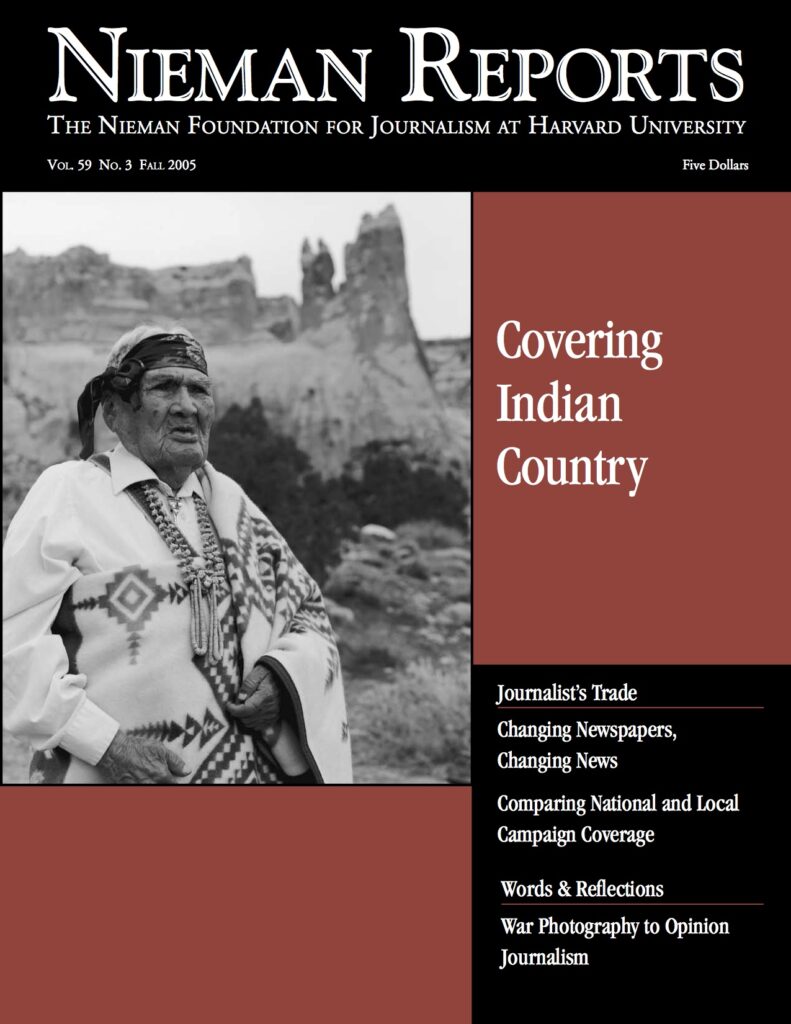In reflecting on the book, “A Matter of Opinion,” Ray Jenkins explains why its author, Victor S. Navasky, so strongly advocates “cutting-edge reporting, with an acknowledged point of view unrestrained by the demands of objectivity,” and shares experiences he had with opinion journalism as editorial page editor of The Evening Sun in Baltimore and his views on what he reads today: “What passes for editorial writing these days is all too often a mishmash of dullness, vacillation, predictability, obscurity and, ultimately, irrelevance.” Gilbert Cranberg, coauthor of “Taking Stock: Journalism and the Publicly Traded Newspaper Company,” reveals that in “Knightfall: Knight Ridder and How the Erosion of Newspaper Journalism Is Putting Democracy at Risk,” its author, Davis Merritt, former editor of the Wichita Eagle, presents “a story in microcosm of journalism generally during an era hit with the double whammy of consolidation and the shortsighted decision by media executives to ‘go public’….” Cranberg uses his own findings to illuminate costs associated with these circumstances.
Working as a photojournalist in Iraq for The Dallas Morning News, David Leeson shared the 2004 Pulitzer Prize for Breaking News Photography with his colleague, Cheryl Diaz-Meyer. Now he writes about enduring issues confronted by war photographers as he contemplates the display of news photographs from the Vietnam War that photojournalist Catherine Leroy collected in “Under Fire: Great Photographers and Writers in Vietnam.” Leeson also shares his images from Iraq. Steve Northup, a photojournalist who was with UPI during the Vietnam War, finds in Leroy’s book a lot of pictures “taken by old friends,” and observes how “Vietnam was different, with its daily realities, some would later argue, all too apparent.” With Iraq, Northup observes, most Americans don’t have “any idea of the terrible suffering that goes on hourly, on every side,” given constraints that photojournalists now work under.
James McCartney, who reported from Washington, D.C. for more than 35 years, tells us about what Donald A. Ritchie unearths in his book, “Reporting from Washington: The History of the Washington Press Corps,” and about aspects of the job he overlooked. “… he fails to examine why the Washington press corps often fails and why it matters when they do,” McCartney writes. “The evidence suggests that the same factors that contributed to the failure in Vietnam were also present 40 years later in the run-up to the war in Iraq.” John Geddes, who is Ottawa bureau chief for Maclean’s, focuses on the early journalistic pursuits of Canadian-born John Kenneth Galbraith, as chronicled by Richard Parker in “John Kenneth Galbraith: His Life, His Politics, His Economics.” Galbraith’s five years at Fortune magazine were, he writes, “a key formative period when his early interest in journalism intersected with his growing confidence as an economist.”
Philadelphia Inquirer columnist and theater reviewer Howard Shapiro contemplates the manipulative forces of media as seen through Thomas de Zengotita’s writing in his book, “Mediated: “How the Media Shapes Your World and the Way You Live in It.” One result is that we “surf everything in life, concentrating on little.” Madeleine Blais, a journalism professor at the University of Massachusetts and narrative book author, finds in Robert S. Boynton’s book, “The New New Journalism: Conversations with America’s Best Nonfiction Writers on Their Craft,” a “useful guidebook” to learn about immersion journalism and “the revolution in nonfiction writing,” launched by John Hersey’s “Hiroshima” in 1946.
Working as a photojournalist in Iraq for The Dallas Morning News, David Leeson shared the 2004 Pulitzer Prize for Breaking News Photography with his colleague, Cheryl Diaz-Meyer. Now he writes about enduring issues confronted by war photographers as he contemplates the display of news photographs from the Vietnam War that photojournalist Catherine Leroy collected in “Under Fire: Great Photographers and Writers in Vietnam.” Leeson also shares his images from Iraq. Steve Northup, a photojournalist who was with UPI during the Vietnam War, finds in Leroy’s book a lot of pictures “taken by old friends,” and observes how “Vietnam was different, with its daily realities, some would later argue, all too apparent.” With Iraq, Northup observes, most Americans don’t have “any idea of the terrible suffering that goes on hourly, on every side,” given constraints that photojournalists now work under.
James McCartney, who reported from Washington, D.C. for more than 35 years, tells us about what Donald A. Ritchie unearths in his book, “Reporting from Washington: The History of the Washington Press Corps,” and about aspects of the job he overlooked. “… he fails to examine why the Washington press corps often fails and why it matters when they do,” McCartney writes. “The evidence suggests that the same factors that contributed to the failure in Vietnam were also present 40 years later in the run-up to the war in Iraq.” John Geddes, who is Ottawa bureau chief for Maclean’s, focuses on the early journalistic pursuits of Canadian-born John Kenneth Galbraith, as chronicled by Richard Parker in “John Kenneth Galbraith: His Life, His Politics, His Economics.” Galbraith’s five years at Fortune magazine were, he writes, “a key formative period when his early interest in journalism intersected with his growing confidence as an economist.”
Philadelphia Inquirer columnist and theater reviewer Howard Shapiro contemplates the manipulative forces of media as seen through Thomas de Zengotita’s writing in his book, “Mediated: “How the Media Shapes Your World and the Way You Live in It.” One result is that we “surf everything in life, concentrating on little.” Madeleine Blais, a journalism professor at the University of Massachusetts and narrative book author, finds in Robert S. Boynton’s book, “The New New Journalism: Conversations with America’s Best Nonfiction Writers on Their Craft,” a “useful guidebook” to learn about immersion journalism and “the revolution in nonfiction writing,” launched by John Hersey’s “Hiroshima” in 1946.



